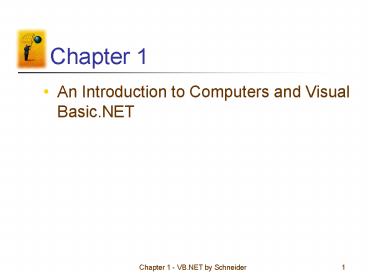An Introduction to Computers and Visual Basic.NET - PowerPoint PPT Presentation
Title:
An Introduction to Computers and Visual Basic.NET
Description:
Skipping most of this in class. An Introduction to Visual ... James Gosling creator of Java. Linus Torvalds - developed the popular Linux operating system. ... – PowerPoint PPT presentation
Number of Views:153
Avg rating:3.0/5.0
Title: An Introduction to Computers and Visual Basic.NET
1
Chapter 1
- An Introduction to Computers and Visual Basic.NET
2
Outline and Objectives
- Introduction to Computers
- Skipping most of this in class, some covered
previously - Using Windows
- Files and Folders
- Skipping most of this in class
- An Introduction to Visual Basic.NET
- Biographical History of Computing
3
Problem Solving
- Developing the solution to a problem
- Algorithm a step by step series of instructions
to solve a problem
4
Types of Problems in this Text
- Business computations
- Managing records
- Managing lists
- And more
- Well have some assignments with a little more of
an entertainment flavor as well
5
VB.NET
- BASIC developed at Dartmouth in the early 1960s
- Visual Basic created by Microsoft in 1991
- VB.NET similar to Visual Basic, but more powerful
6
Skipping in Class
- Internet and the WWW
- Using Windows PC Literacy Topics
- Using the mouse double-clicking, hovering,
dragging, etc. - Moving windows
- Navigating the C\ drive for files
- Opening, closing files, copying files
- Using WinZip
- See text for more information
7
Introduction to Visual Basic .NET
- Language used to create Windows application.
- Provides a Graphical User Interface or GUI.
- The sequence of instructions executed in the
program is controlled by events.
8
Sample Input Screen
9
How to Develop a VB.NET Application
- Design the Interface for the user.
- Determine which events the controls on the window
should recognize. - Write the event procedures for those events.
10
Different Versions of Visual Basic
- Version 1.0 1991
- Version 2.0 1992
- Version 3.0 1993
- Version 4.0 1995
- Version 5.0 1997
- Version 6.0 1998
- VB.NET 2002 NOT BACKWARD COMPATIBLE WITH
EARLIER VERSIONS OF VISUAL BASIC
11
1.5 Biographical History of Computing
12
1800s
- George Boole devised Boolean algebra
- Charles Babbage created "analytical engine"
- Augusta Ada Byron first computer programmer
- Herman Hollerith founder of company that would
become IBM
13
1930s
- Alan Turing deciphered German code in WWII
design of computer systems, theory, software,
determined what is possible for computers to
compute - John V. Atanasoff inventor of first electronic
digital special purpose computer
14
1940s
- Howard Aiken built large scale digital
computer, Mark I - Grace M. Hopper originated term "debugging"
pioneered development and use of COBOL - John Mauchley and J. Presper Eckert built first
large scale general purpose computer, ENIAC
15
1940s continued
- John von Neumann developed stored program
concept - Maurice V. Wilkes built EDSAC, first computer
to use stored program concept - John Bardeen, Walter Brattain, and William
Shockley developed transistor that replaced
vacuum tubes
16
1950s
- John Backus created Fortran early user of
interpreters and compilers - Reynold B. Johnson invented the disk drive
- Donald L. Shell developed efficient sorting
algorithm
17
1960s
- John G. Kemeny and Thomas E. Kurtz invented
BASIC - Corrado Bohm and Guiseppe Jacopini proved that
any program can be written with only 3
structures sequence, decision, and loops - Edsger W. Dijkstra stimulated move to
structured programming by declaring "GOTO" harmful
18
1960s continued
- Harlan B. Mills advocated use of structured
programming - Donald E. Knuth wrote definitive work on
algorithms - Ted Hoff, Stan Mazer, Robert Noyce, and Frederico
Faggin developed first microprocessor
19
1960s continued
- Douglas Engelbart invented computer mouse
20
1970s
- Ted Codd - software architect laid the
groundwork for relational databases - Paul Allen and Bill Gates - cofounders of
Microsoft Corporation - Stephen Wozniak and Stephen Jobs - cofounders of
Apple Computer Inc. - Dan Bricklin and Dan Fylstra - wrote VisiCalc,
the first electronic spreadsheet program
21
1970s continued
- Dennis Ritchie - creator of the C programming
language. - Ken Thompson - created the Unix operating system
- Alan Kay developer of Smalltalk, a pure
object-oriented language - Don Chamberlain - created a database programming
language, later known as SQL,
22
1980s
- Phillip Don Estridge - at IBM directly
responsible for the success of the personal
computer. - Mitchell D. Kapor - cofounder of Lotus
Corporation - Tom Button - group product manager for
applications programmability at Microsoft headed
the team that developed QuickBasic, QBasic, and
Visual Basic.
23
1980s continued
- Alan Cooper - considered the father of Visual
Basic. - Tim BernersLee - father of the World Wide Web.
- Charles Simonyi - the father of Word.
- Bjarne Stroustrup - creator of the C
programming language. - Richard M. Stallman - founded Free Software
Foundation
24
1990s
- Marc Andreessen - inventor of the Web browser.
- James Gosling creator of Java.
- Linus Torvalds - developed the popular Linux
operating system.
25
1990s continued
- Brain Behlendorf, Rob McCool, and Roy Fielding -
developers of the Apache HTTP server, an
open-source Web server that can scale up quickly
to handle high volumes of traffic.
26
2000 - today
- ? You?































